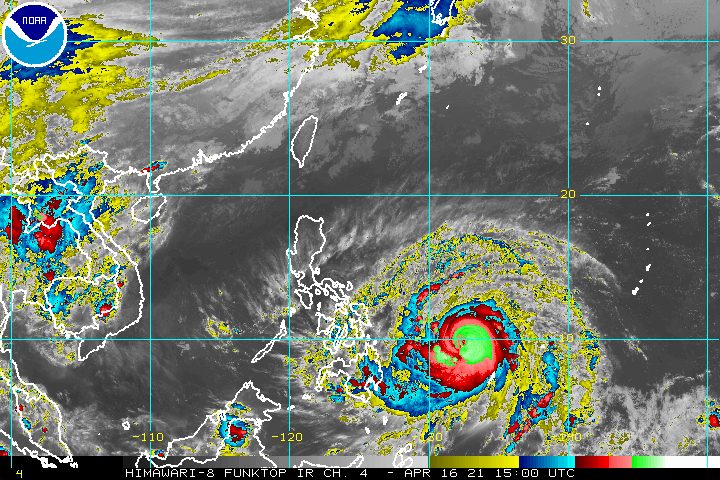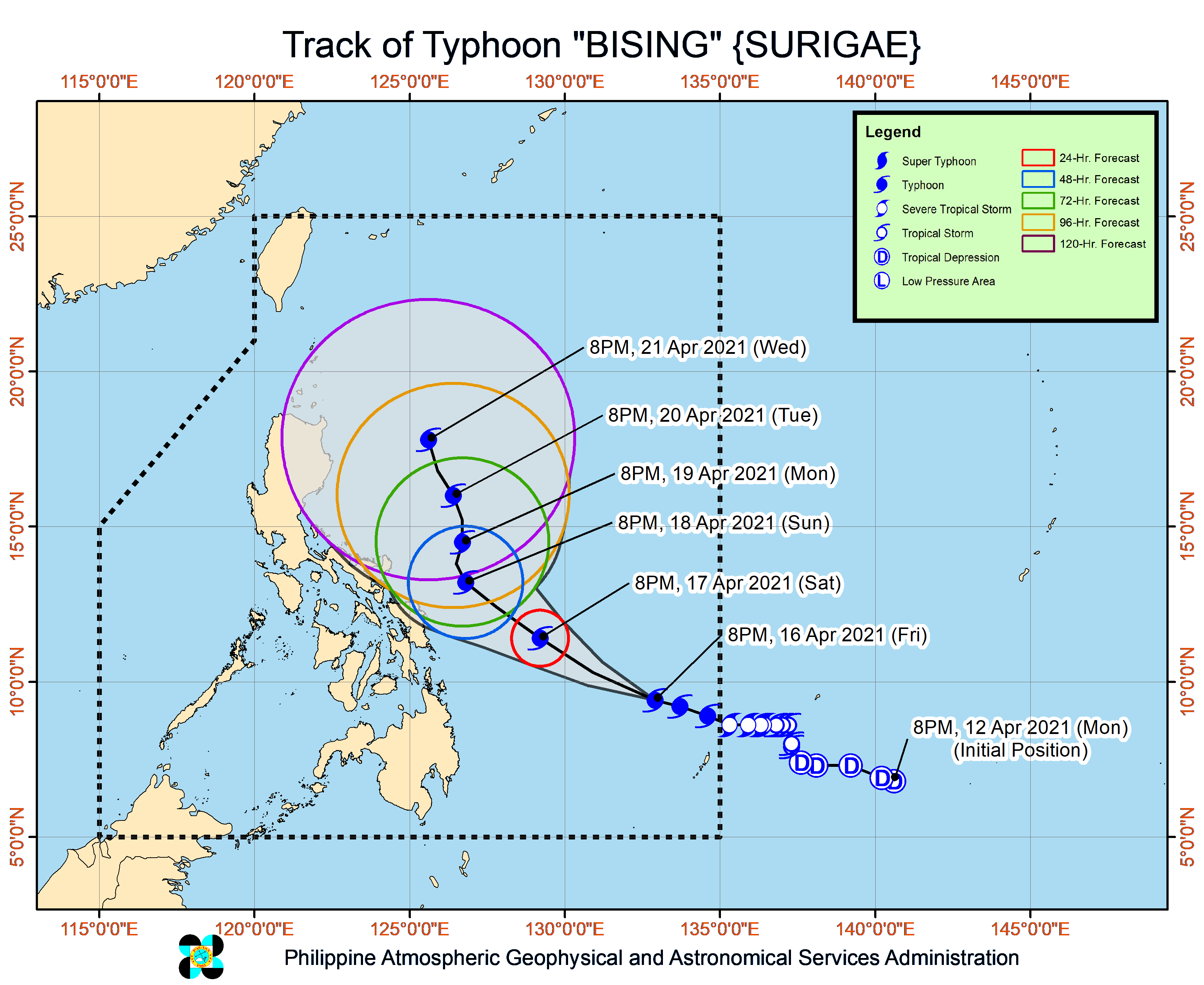SUMMARY
This is AI generated summarization, which may have errors. For context, always refer to the full article.

The possibility of intense rain was raised and some areas were placed under Signal No. 1 due to Typhoon Bising (Surigae) for the first time on Friday evening, April 16, as the tropical cyclone “rapidly intensified” over the Philippine Sea.
In a bulletin issued 11 pm on Friday, the Philippine Atmospheric, Geophysical, and Astronomical Services Administration (PAGASA) said Bising now has maximum sustained winds of 150 kilometers per hour (km/h) and gustiness of up to 185 km/h.
Earlier on Friday afternoon, it had maximum sustained winds of 130 km/h and gustiness of up to 160 km/h.
PAGASA said Bising may reach its peak intensity of 175 to 195 km/h by Sunday, April 18, still a typhoon. (READ: FAST FACTS: Tropical cyclones, rainfall advisories)
As of Friday evening, Bising was located 790 kilometers east of Surigao City, Surigao del Norte, moving west northwest at 15 km/h.
The typhoon will generally maintain a west northwest or northwest direction over the Philippine Sea until Monday, April 19, according to PAGASA. Then it could slow down and move more toward the north until Tuesday evening, April 20, which would spare the country from landfall.
Due to its wide diameter, however, Bising is likely to bring rain and winds even if it will not hit land.
PAGASA warned of moderate to heavy rain, with at times intense rain, in Eastern Visayas and Camotes Islands between late Saturday evening, April 17, and late Sunday afternoon, April 18.
Those areas must prepare for possible floods and landslides.
Meanwhile, Signal No. 1 is now raised in the following areas in the Eastern Visayas and Caraga regions to warn of looming winds:
- Eastern Samar
- eastern part of Northern Samar (Las Navas, Catubig, Laoang, Palapag,
Mapanas, Gamay, Lapinig) - central and southern parts of Samar (Marabut, Basey, Santa Rita, Villareal, Talalora, Daram, Pinabacdao, Zumarraga, Calbiga, San Sebastian, Hinabangan, Paranas, Motiong, Jiabong, Catbalogan City, Tarangnan, San Jorge, Pagsanghan, Gandara, Matuguinao, San Jose de Buan)
- eastern part of Leyte (Abuyog, Mahaplag, Javier, MacArthur, Mayorga, La Paz, Dulag, Julita, Burauen, Tolosa, Tanauan, Tabontabon, Dagami, Pastrana, Palo, Jaro, Alangalang, Santa Fe, Tacloban City, Babatngon, San Miguel, Barugo, Tunga)
- eastern part of Southern Leyte (Sogod, Silago, Hinunangan, Hinundayan, Anahawan, San Juan, Saint Bernard, Libagon, Liloan, San Ricardo, Pintuyan, San Francisco)
- Dinagat Islands
- Surigao del Norte, including Siargao and Bucas Grande Islands
- Surigao del Sur
“Tropical cyclone winds of at least strong breeze to near gale in strength extend outward up to 500 kilometers from the center of the typhoon,” PAGASA said.
The state weather bureau added that Signal No. 2, for now, is expected to be the highest tropical cyclone wind signal that would be raised due to Bising. But if the typhoon shifts further west toward land, instead of north and away from land, some areas might be placed under higher wind signals.
In the next 24 hours, Bising will also trigger rough to very rough seas in the eastern seaboards of these areas:
- Bicol (waves 2.5 to 4 meters high)
- Eastern Visayas (waves 2.5 to 6 meters high)
- Caraga (waves 2.5 to 5.5 meters high)
- Davao Region (waves 2.5 to 3 meters high)
Travel will be risky for all types of vessels, warned PAGASA.

Bising is the Philippines’ second tropical cyclone for 2021. The country usually gets an average of 20 tropical cyclones each year. (READ: LIST: PAGASA’s names for tropical cyclones in 2021)
For the next 6 months, PAGASA estimates the following number of tropical cyclones inside the Philippine Area of Responsibility:
- April – 0 or 1
- May – 0 or 1
- June – 1 or 2
- July – 1 to 3
- August – 2 or 3
- September – 2 or 3
– Rappler.com
Add a comment
How does this make you feel?




There are no comments yet. Add your comment to start the conversation.